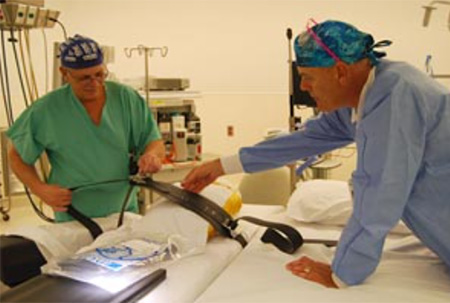Patient care and high quality define new surgery suites at UC Davis Medical Center
With the move on Sept. 14 to the UC Davis Medical Center's new Surgical and Emergency Services Pavilion, surgery patients gained the convenience of one-stop check-in, beautifully appointed waiting areas, a well-lighted atrium and a nearby cafeteria.

“There’s a sense of openness and light throughout the building. It was definitely designed with a patient-care focus,” said Philip Schneider, director of Perioperative Services at UC Davis.
While the move does not mean more operating rooms, it does mean much larger, standard-shaped rooms that can easily accommodate all equipment required for highly complex surgeries — from bariatric to burn, and from cardiothoracic to cancer. The previous facilities represent decades of a “make it happen now” approach to growth that was necessary to accommodate increasing patient volume within existing walls. As a result, surgery facilities spanned three distinct locations in the hospital, and the rooms were often irregularly shaped or simply too small to accommodate technologies required to support certain cases. In the new surgery suites, all essential supporting services are consistent and consolidated.
Modern ORs are all about instant communication between distant locations, and these capabilities have been very thoughtfully integrated into our new facilities.”—Philip Schneider
“The ease of logistics in the new building offers much greater efficiencies in scheduling and overall operations,” says Schneider.

One example of those efficiencies is in Central Processing, which provides surgical teams with sterilized operating instruments. In the new Pavilion, the unit is co-located with Surgery and has elevators with direct access to operating rooms, rather than delivering instruments throughout the hospital.
The operating rooms will also be equipped with capabilities to share voice and visual information securely over the Internet, allowing surgeons to share clinical information with other surgeons or pathologists or to provide training to medical students and residents.
Quick facts about the UC Davis Medical Center's new ORs
• Twenty-four new inpatient operating rooms
— Uniform physical layout for each operating room
— Extensive use of technology to enhance, improve capabilities
— Audio/video streaming to allow for real-time, collaborative diagnosis and treatment from disparate locations
— Powered by high-speed, secure data networks, which allow practitioners to pull data from multiple locations safely and quickly
— Allows images from a variety of sources, such as a camera, microscope or ultrasound, to be viewed on any of the multiple display monitors in each
• Connected directly to emergency and trauma via dedicated elevator
• Post-anesthesia care unit (PACU)
• 10-bed cardiothoracic surgical intensive care unit
• 10-bed neurosurgery intensive care unit
• Denny and Jeanene Dickenson Surgery and ICU Waiting Area
“Modern ORs are all about instant communication between distant locations, and these capabilities have been very thoughtfully integrated into our new facilities,” Schneider said.
Schneider is especially excited about the new endovascular suite, which allows for hybrid surgical procedures in one location. In that room, a surgeon can conduct non-invasive and open vascular surgery at the same time, which can be necessary in treating conditions such as peripheral artery disease.
“These operations can be done separately, but there’s much less risk and much shorter recovery time with the combined approach,” Schneider adds. “With the capabilities to do both in one OR, there will be less much need for two separate procedures.”
Configuring the hybrid suite is still under way, however the rest of the move is now complete. Schneider says the process was “truly remarkable” due to the teamwork involved.
“It’s a joy to work with very smart and dedicated people who put a lot of time and energy into making sure the transition happened as smoothly and quickly as possible,” he says.




